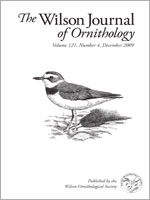We studied breeding biology, parental roles, and social mating system of the Bay-capped Wren-Spinetail (Spartonoica maluroides), a habitat specialist furnariid, in the Argentinean pampas. We found 42 nests during 2004–2007, two during egg laying, 28 during incubation, and 12 with nestlings. Mean clutch size was 3.17 eggs (n = 29), the incubation period was 13 days, and nestlings remained in the nest for 12 days before fledgling. Bay-capped Wren-Spinetails are socially monogamous; both males and females develop a brood patch and contribute to incubation, brooding, and provisioning of nestlings. Wren-Spinetails are unique among furnariids as they build an open cup nest with a few presenting a loose domed roof. Breeding success of Bay-capped Wren-Spinetails was higher (total probability of nesting success = 0.508) than other species of sympatric passerines because of low nest predation and high nest survival rates during incubation and nestling rearing stages.
How to translate text using browser tools
1 December 2009
Breeding Success and Social Mating System of the Bay-capped Wren-Spinetail (Spartonoica maluroides)
Paulo E. Llambías,
Valentina Ferretti,
Daniel A. Cardoni,
Jesús E. Maldonado
ACCESS THE FULL ARTICLE





